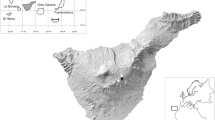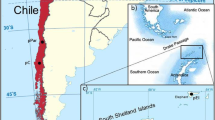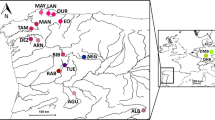Abstract
The habitat in the Natural Reserve of the Tarquinia salterns, located on the Tyrrhenian coast of central Italy, has undergone dramatic alterations over the last 10 years. After salt production was terminated in 1997 the site was abandoned until 2002, with consequent degradation of habitat quality and stiffening of the environmental conditions. From 2003 to 2006 ecological rehabilitation of the site was carried out, restoring water circulation to its previous equilibrium. The genetic variation in the killifish Aphanius fasciatus inhabiting the salterns was monitored using allozymes from 1998. The results showed that the genetic variability of the killifish strongly reduced through time: a high number of rare alleles were lost and both heterozygosity and allele richness were significantly decreased. The most recent samples, taken after the ecological restoration, showed that to date the genetic erosion of A. fasciatus gene pool has slowed down, since no significant differences have been detected for any genetic variability parameter. Concerning the mechanisms leading to the impoverishment of the genetic variability, the strong loss of rare alleles suggests a role of genetic drift, which accords with the fluctuation of the effective population size recorded over the period of study and with the low gene flow typical of this species. The low levels of gene flow reported for this species imply that once lost, the genetic variability can rarely be restored through immigration from highly variable populations.

Similar content being viewed by others
References
Barcia AR, López GE, Hernández D, García-Machado E (2005) Temporal variation of the population structure and genetic diversity of Farfantepenaeus notialis assessed by allozyme loci. Mol Ecol 14:2933–2942
Belfiore NM, Anderson SL (2001) Effects of contaminants on genetic patterns in aquatic organisms: a review. Mutat Res 489:97–122
Bickham JW, Sandhu S, Hebert PDN, Chikhi L, Athwal R (2000) Effects of chemical contaminants on genetic diversity in natural populations: implications for biomonitoring and ecotoxicology. Mutat Res 463:33–51
Blasi S (2006) Structure, seasonal fluctuations and response to disturbance of macroinvertebrate assemblages in hyperaline mediterranean habitat: Tarquinia saltpans. PhD Thesis, University of Tuscia, Viterbo (Italy), p 145. Available from http://dspace.unitus.it/dspace/handle/2067/109
Boessenkool S, Star B, Seddon PJ, Waters JM (2010) Temporal genetic samples indicate small effective population size of the endangered yellow-eyed penguin. Conserv Genet 11:539–546
Bramucci S (2009) Analysis of macrozoobentic and planktonic communities in a hypersaline aquatic environment: Tarquinia Salterns. PhD Thesis, University of Tuscia, Viterbo (Italy), p 150
Carroll SP, Hendry AP, Reznick DN, Fox CW (2007) Evolution on ecological time-scales. Funct Ecol 21:387–393
Cimmaruta R, Iaconelli M, Nascetti G, Bullini L (1998) Diversitá genetica in popolazioni di grandi pelagici del Mediterraneo. Biol Mar Medit 5:300–310
Cimmaruta R, Scialanca F, Luccioli F, Nascetti G (2003) Genetic diversity and environmental stress in Italian populations of the cyprinodont fish Aphanius fasciatus. Oceanol Acta 26:101–110
Cimmaruta R, Bondanelli P, Nascetti G (2005) Genetic structure and environmental heterogeneity in the European hake (Merluccius merluccius). Mol Ecol 14:2577–2591
Cimmaruta R, Bondanelli P, Ruggi A, Nascetti G (2008) Genetic structure and temporal stability in the horse mackerel (Trachurus trachurus). Fish Res 89:114–121
Cornuet JM, Luikart G (1996) Description and power analysis of two tests for inferring recent population bottlenecks from allele frequency data. Genetics 144:2001–2014
DiBattista JD (2008) Patterns of genetic variation in anthropogenically impacted populations. Conserv Genet 9:141–156
Eanes WF (2002) Analysis of selection on enzyme polymorphisms. Annu Rev Ecol Syst 30:301–326
El Mousadik A, Petit RJ (1996) High level of genetic differentiation for allelic richness among populations of the argan tree (Argania spinosa (L.) Skeels) endemic to Morocco. Theor Appl Genet 92:832–839
Fischer W, Schneider M, Bauchot ML (1987) Fiches FAO d’identification des espèces pour les besoins de la pêche. Mèditerranèe et Mer Noire, (Zone de la pêche 37). Revision I. Volume II. Vertèbrès. FAO CEE, Rome, pp 761–1529
Frankham R (1995) Conservation genetics. Annu Rev Genet 29:305–327
Frankham R (1996) Relationship of genetic variation to population size in wildlife. Conserv Biol 10:1500–1508
Fraser DJ, Hansen MM, Ostergaard S, Tessier N, Legault M, Bernatchez L (2007) Comparative estimation of effective population sizes and temporal gene flow in two contrasting population system. Mol Ecol 16:3866–3889
Funk WC, Forsman ED, Johnson M, Mullins TD, Haig SM (2010) Evidence for recent population bottlenecks in northern spotted owls (Strix occidentalis caurina). Conserv Genet 11:1013–1021
Goudet J (2001) FSTAT, a program to estimate and test gene diversities and fixation indices (version 2.9.3). Available from http://www2.unil.ch/popgen/softwares/fstat.htm. Updated from Goudet (1995) FSTAT version 1.2: a computer program to calculate F-statistics. J Hered 86:485–486
Gysels ES, Leentjes V, Volckaert FAM (2004) Small-scale clinal variation, genetic diversity and environmental heterogeneity in the marine gobies Pomatoschistus minutus and P. lozanoi (Gobiidae, Teleostei). Heredity 93:208–214
Hartl DL, Clark AG (1989) Principles of population genetics. Sinauer Associates, Sunderland
Hauser L, Adcock GJ, Smith PJ, Bernal Ramirez JH, Carvalho GR (2002) Loss of microsatellite diversity and low effective population size in an overexploited population of New Zealand snapper (Pagrus auratus). Proc Natl Acad Sci USA 99:11742–11747
Hedgecock D (1994) Does variance in reproductive success limit effective population sizes of marine organisms? In: Beaumont AR (ed) Genetics and evolution of aquatic organisms. Chapman & Hall, London, pp 122–134
Hedrick PW (2000) Genetics of populations. Jones and Bartlett Publishers, Sudbury
Hewitt GM (2000) The genetic legacy of the quaternary ice ages. Nature 405:907–913
Hoarau G, Piquet AMT, Rijnsdorp AD, Van Der Veer HW, Stam WT, Olsen JL (2004) Population structure of plaice (Pleuronectes platessa) in northern Europe: a comparison of resolving power between microsatellite and mtDNA data. J Sea Res 51:183–190
Hoarau G, Boon E, Jongma DN, Ferber S, Palsson J, Van der Veer HW, Rijnsdorp AD, Stam WT, Olsen JL (2005) Low effective population size and evidence for inbreeding in an overexploited flatfish, plaice (Pleuronectes platessa L.). Proc R Soc B Biol Sci 272:497–503
Hoelzel AL (1999) Impact of population bottlenecks on genetic variation and the importance of life-history; a case study of the northern elephant seal. Biol J Linn Soc 68:23–39
Hoffmann AA, Willi Y (2008) Detecting genetic responses to environmental change. Nat Rev Genet 9:421–432
Hutchinson WF, van Oosterhout C, Rogers SI, Carvalho GR (2003) Temporal analysis of archived samples indicates marked genetic changes in declining North Sea cod (Gadus morhua). Proc R Soc B Biol Sci 270:2125–2132
Kidwell DM, Lewitus AJ, Brandt S, Jewett EB, Mason DM (2009) Ecological impacts of hypoxia on living resources. J Exp Mar Biol Ecol 381(Suppl 1):S1–S3
Kimura M, Crow JF (1964) The number of alleles that can be maintained in a finite population. Genetics 49:725–738
Krafsur SE (2002) Population structure of the tsetse fly Glossina pallidipes estimated by allozyme, microsatellite and mitochondrial gene diversities. Insect Mol Biol 11:37–45
Lardicci C, Rossi F, Castelli A (1997) Analysis of macrozoobenthic community structure after severe dystrophic crises in a mediterranean coastal lagoon. Mar Pollut Bull 34:536–547
Lardicci C, Como S, Corti S, Rossi F (2001) Recovery of the macrozoobenthic community after severe dystrophic crises in a mediterranean coastal lagoon (Orbetello, Italy). Mar Pollut Bull 42:202–214
Leonardos I, Sinis A (1998) Reproductive strategy of Aphanius fasciatus Nardo, 1827 (Pisces, Cyprinodontidae) in the Mesolongi and Etolikon lagoons (W. Greece). Fish Res 35:171–181
Leonardos I, Sinis A (1999) Population age and sex structure of Aphanius fasciatus Nardo, 1827 (Pisces, Cyprinodontidae) in the Mesolongi and Etolikon lagoons (W. Greece). Fish Res 40:227–235
Luikart G, Sherwin WB, Steele BM, Allendorf FW (1998) Usefulness of molecular markers for detecting population bottlenecks via monitoring genetic change. Mol Ecol 7:963–974
Maes GE, Raeymaekers JAM, Pampoulie C, Seynaeve A, Goemans G, Belpaire C, Volckaert FAM (2005) The catadromous European eel Anguilla anguilla (L.) as a model for freshwater evolutionary ecotoxicology: relationship between heavy metal bioaccumulation, condition and genetic variability. Aquat Toxicol 73:99–114
Maltagliati F (1998a) Preliminary investigation of allozyme genetic variation and population geographical structure in Aphanius fasciatus from Italian brackish-water habitats. J Fish Biol 52:1130–1140
Maltagliati F (1998b) Does the Mediterranean killifish Aphanius fasciatus (Teleostei: Cyprinodontidae) fit the one-dimensional stepping-stone model of gene flow? Environ Biol Fish 53:385–392
Maltagliati F (1999) Genetic divergence in natural populations of the Mediterranean brackish-water killifish Aphanius fasciatus. Mar Ecol Prog Ser 179:155–162
Maltagliati F, Camilli L (2000) Temporal genetic variation in a population of Aphanius fasciatus (Cyprinodontidae) from a brackish-water habitat at Elba Island (Italy). Env Biol Fish 57:107–112
Nei M, Maruyama T, Chakraborty R (1975) The bottleneck effect and genetic variability in populations. Evolution 29:1–10
Nevo E (2001) Evolution of genome-phenome diversity under environmental stress. PNAS 98:6233–6240
Nevo E, Noy R, Lavie B, Beiles A, Muchtar S (1986) Genetic diversity and resistance to marine pollution. Biol J Linn Soc 29:139–144
Nowak C, Vogt C, Pfenninger M, Schwenk K, Oehlmann J, Streit B, Oetken M (2009) Rapid genetic erosion in pollutant-exposed experimental chironomid populations. Environ Pollut 157:881–886
Nunney L (1996) The influence of variation in female fecundity on effective population size. Biol J Linn Soc 59:411–425
Ozbek O, Millet E, Anikster Y, Arslan O, Feldman M (2007) Spatio-temporal genetic variation in populations of wild emmer wheat, Triticum turgidum ssp. dicoccoides, as revealed by AFLP analysis. Theor Appl Genet 115:19–26
Palstra FP, Ruzzante DE (2008) Genetic estimates of contemporary effective population size: what can they tell us about the importance of genetic stochasticity for wild populations persistence? Mol Ecol 17:3428–3447
Piry SG, Luikart G, Cornuet JM (1999) BOTTLENECK: a computer program for detecting recent reductions in the effective populations size using allele frequency data. J Hered 90:502–503
Raymond M, Rousset F (1995) GENEPOP (version 1.2): population genetic software for exact test and ecumenicism. J Hered 86:248–249
Ryman N, Utter F, Laikre L (1995) Protection of intraspecific biodiversity of exploited fishes. Rev Fish Biol Fish 5:417–446
Schneider S, Roessli D, Excoffier L (2000) ARLEQUIN Ver. 2.000: a software for population genetics data analysis. Genetics and Biometry Laboratory, University of Geneva, Geneva
Schwartz MK, Luikart G, Waples RS (2007) Genetic monitoring as a promising tool for conservation and management. TREE 22:25–33
Smith PJ, Francis RICC, McVeagh M (1991) Loss of genetic diversity due to fishing pressure. Fish Res 10:309–316
Spear SF, Petesron CR, Matocq MD, Storfer A (2006) Molecular evidence for historical and recent population size reductions of tiger salamanders (Ambystoma tigrinum) in Yellowstone National Park. Conserv Genet 7:605–611
Stanton ML, Roy BA, Thiede DA (2000) Evolution in stressful environments. I. Phenotypic variability, phenotypic selection, and response to selection in five distinct environmental stresses. Evolution 54:93–111
Swofford DL, Selander RB (1999) BIOSYS-2: a computer program for the analysis of allelic variation in population genetics. University of Illinois at Urbana-Champaign, Urbana
Tortonese E (1986) Cyprinodontidae. In: Whitehead PJP, Bauchot ML, Hureau JC, Nielsen J, Tortonese E (eds) Fishes of the north-eastern Atlantic and the Mediterranean. UNESCO, Paris, pp 1341–1345
Turner TF, Wares JP, Gold JR (2002) Genetic effective size is three order of magnitude smaller than adults census size in an abundant, estuarine-dependant marine fish (Sciaenops ocellatus). Genetics 162:1329–1339
Ungherese G, Mengoni A, Somigli S, Baroni D, Focardi S, Ugolini A (2010) Relationship between heavy metals pollution and genetic diversity in Mediterranean populations of the sandhopper Talitrus saltator (Montagu) (Crustacea, Amphipoda). Environ Pollut 158:1638–1643
van Straalen NM, Timmermans JTN (2002) Genetic variation in toxicant-stressed populations: an evaluation of the “genetic erosion” hypothesis. Hum Ecol Risk Assess 5:983–1002
Vucetich JA, Waite TA, Nunney L (1997) Fluctuating population size and the ratio of effective to census population size. Evolution 51:2017–2021
Wang J (2001) A pseudo-likelihood method for estimating effective population size from temporally spaced samples. Genet Res 78:243–257
Wang J, Whitlock MC (2003) Estimating effective population size and migration rates from genetic samples over space and time. Genetics 163:429–446
Waples RS (1989) A generalized approach for estimating effective population size from temporal changes in allele frequency. Genetics 121:379–391
Waples RS (1991) Genetic methods for estimating the effective size of Cetacean populations. Report Int Whaling Commission Spec Issue 13:279–300
Waples RS, Yokota M (2007) Temporal estimates of effective populations size in species with overlapping generations. Genetics 175:219–233
Weir BS, Cockerham CC (1984) Estimating F-statistics for the analysis of population structure. Evolution 38:1358–1370
Willi Y, Van Buskirk J, Schmid B, Fischer M (2007) Genetic isolation of fragmented populations is exacerbated by drift and selection. J Evol Biol 20:534–542
Williamson-Natesan EG (2005) Comparison of methods for detecting bottlenecks from microsatellite loci. Conserv Genet 6:551–562
Acknowledgments
This study forms part of a EU LIFE-NATURA project “Environmental rehabilitation of the Natural Reserve of Tarquinia Salt-works” (LIFE02NAT/IT/8523), carried out with the contribution of the European Commission, Directorate-General Environment. We wish to thank Paola Bondanelli and Alessandra Pontremolesi for their valuable help in data collection and Sara Rosenman for reviewing the English text. We also thank three anonymous referees for their valuable observations.
Author information
Authors and Affiliations
Corresponding author
Rights and permissions
About this article
Cite this article
Angeletti, D., Cimmaruta, R. & Nascetti, G. Genetic diversity of the killifish Aphanius fasciatus paralleling the environmental changes of Tarquinia salterns habitat. Genetica 138, 1011–1021 (2010). https://doi.org/10.1007/s10709-010-9487-3
Received:
Accepted:
Published:
Issue Date:
DOI: https://doi.org/10.1007/s10709-010-9487-3




